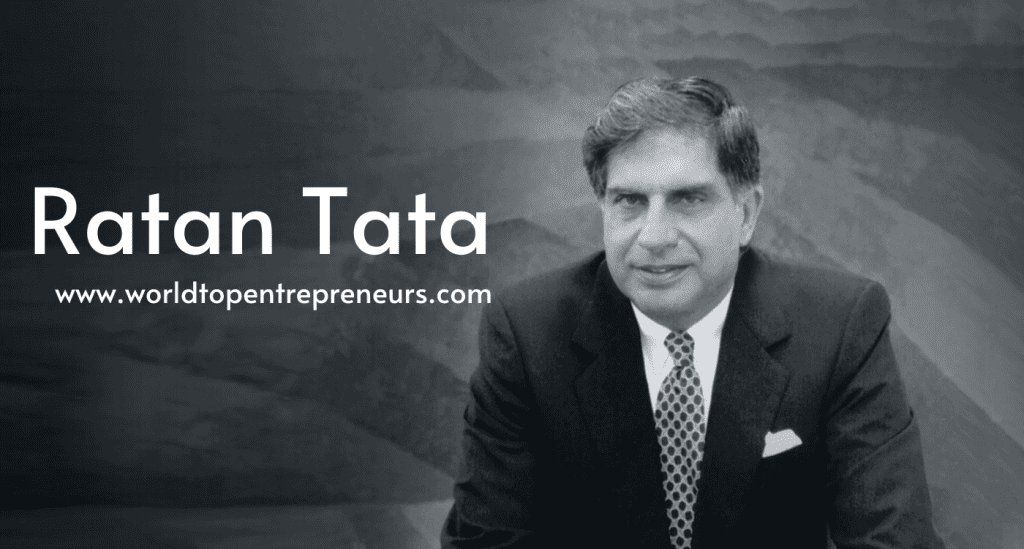Ratan Tata, a name synonymous with the success and global stature of the Tata Group, is widely regarded as one of India’s most influential business leaders. As the former Chairman of Tata Sons, Tata Group’s holding company, Ratan Tata played a pivotal role in shaping the future of many companies under its umbrella, including Tata Motors—one of India’s largest and most diversified automobile manufacturers.
Ratan Tata’s entrepreneurial journey, characterized by bold decisions, innovative strategies, and a global vision, transformed Tata Motors into an international powerhouse. This blog delves into Ratan Tata’s entrepreneurial journey, his educational and business background, the struggles and successes he faced, and the profound impact he made on Tata Motors and the global automotive industry.
Early Life and Educational Background
Ratan Tata was born on December 28, 1937, into one of India’s most prestigious industrial families. He is the grand-nephew of J.R.D. Tata, one of India’s greatest industrialists and a visionary who laid the foundations of the Tata Group. Growing up in such an influential family, Ratan Tata was exposed to the world of business and entrepreneurship from an early age. However, his approach to leadership would be defined by humility, compassion, and a deep sense of responsibility toward society.
Tata’s educational journey began at The Bishop’s School in Pune, after which he moved to the Cathedral and John Connon School in Mumbai. His academic foundation was further solidified when he moved abroad to study at Cornell University, where he earned a degree in architecture. His time at Cornell shaped his analytical skills and gave him a broader global perspective. To complement his architectural studies, Ratan Tata pursued a Management Program at the Harvard Business School, where he honed his leadership and business management skills.
Ratan Tata’s Early Career and Entry into Tata Group
Ratan Tata joined Tata Group in 1962, starting out at Tata Steel in Jamshedpur, where he worked in various capacities, including overseeing shop floor operations. His early years in the Tata Group were marked by hands-on experience, where he learned the ropes of the industry, managing challenges, and navigating the complexities of running large industrial operations. However, his real leadership journey began in the 1990s when he took over as the Chairman of Tata Group.
In 1991, Ratan Tata succeeded J.R.D. Tata as the Chairman of the Tata Group, marking the beginning of a new era for the conglomerate. While J.R.D. Tata was known for his visionary leadership, Ratan Tata’s approach was more focused on global expansion, modernization, and diversification of the Tata Group. Tata Motors, then known as Tata Engineering and Locomotive Co. Ltd. (TELCO), was one of the key companies in the group, and under Ratan Tata’s leadership, it would go on to make some of the most audacious moves in the history of the Indian automotive industry.
Ratan Tata’s Leadership at Tata Motors
Ratan Tata’s leadership of Tata Motors is defined by visionary decisions, strategic acquisitions, and a long-term commitment to making the company a global player. He took over as the Chairman of Tata Motors in 1998, at a time when the company was largely focused on the Indian market, manufacturing commercial vehicles and trucks. However, Ratan Tata had a broader vision for the company and made bold decisions that would transform it into an international automotive giant.
- The Acquisition of Jaguar Land Rover (JLR) One of the most defining moments of Ratan Tata’s leadership was his successful acquisition of the iconic British brands Jaguar and Land Rover in 2008. This move was a bold and risky one, given the global financial crisis at the time. Tata Motors bought these luxury brands from Ford Motor Company for $2.3 billion, an amount that was seen as a gamble by many in the industry. However, Ratan Tata’s foresight proved invaluable. Under his leadership, Tata Motors revitalized Jaguar and Land Rover, introducing new models, improving quality, and expanding into new markets. The acquisition not only helped Tata Motors expand its product portfolio but also gave the company a significant presence in the luxury car market—an area previously dominated by European and American automakers. This acquisition is widely regarded as one of the most successful takeovers in the automotive industry and a testament to Ratan Tata’s ability to think long-term and take calculated risks.
- The Launch of the Tata Nano Another key milestone under Ratan Tata’s leadership was the Tata Nano, the world’s most affordable car, which was launched in 2008. Ratan Tata’s vision for the Nano was to create a vehicle that would provide mobility to millions of middle-class families in India and developing countries, offering an alternative to motorcycles. The Nano was a revolutionary product, and its price tag of ₹100,000 (approximately $2000) was a game-changer in the automotive industry. Despite facing some challenges with production delays and consumer perception, the Tata Nano garnered worldwide attention for its bold design and affordable price point. It was a perfect reflection of Ratan Tata’s commitment to creating innovative solutions that could transform society. While the Nano may not have achieved the sales figures expected, it remains an important milestone in Tata Motors’ journey and a symbol of Ratan Tata’s drive to innovate and disrupt the market.
- Global Expansion Under Ratan Tata’s leadership, Tata Motors expanded its operations internationally. Beyond the JLR acquisition, the company made strategic moves to enter new markets and diversify its product offerings. Tata Motors became a global player, manufacturing vehicles across several categories, including commercial vehicles, passenger cars, and electric vehicles. Ratan Tata also led the company’s expansion into emerging markets like Africa, Latin America, and Southeast Asia, where demand for commercial vehicles and affordable cars was growing rapidly. His leadership ensured that Tata Motors would become a recognized name on the global automotive stage, competing with established brands from the U.S., Europe, and Japan.
Struggles and Challenges Faced by Ratan Tata
Despite Ratan Tata’s many successes, his entrepreneurial journey was not without struggles. Some of the major challenges he faced during his tenure at Tata Motors include:
- The Nano’s Market Reception: While the Tata Nano was an ambitious project, its reception in the market was not as strong as expected. The car faced several hurdles, including production delays, concerns over safety, and challenges in brand positioning. These issues, coupled with the perception that the Nano was too cheap and not aspirational enough, led to slower-than-expected sales.
- The 2008 Financial Crisis: The global financial crisis of 2008 posed significant challenges for Tata Motors, especially after the acquisition of Jaguar and Land Rover. The crisis led to declining sales for luxury cars, and Tata Motors had to work hard to turn around the fortunes of JLR. However, Ratan Tata’s leadership during this difficult period helped stabilize the company’s operations and restore profitability to JLR.
- Competition in the Global Market: As Tata Motors expanded into global markets, it faced stiff competition from well-established players like Volkswagen, Toyota, and General Motors. Competing on quality, innovation, and brand recognition required continuous investment in research and development, which put pressure on Tata Motors’ resources.
Successes and Achievements
Ratan Tata’s leadership at Tata Motors was marked by several key successes and achievements:
- Jaguar Land Rover Turnaround: The turnaround of Jaguar Land Rover under Tata Motors is one of Ratan Tata’s most significant achievements. The brands were struggling financially when they were acquired, but Tata Motors’ strategic investments, new product introductions, and focus on improving quality helped make JLR a profitable and respected brand again.
- Global Expansion: Ratan Tata’s efforts to expand Tata Motors into global markets were highly successful. The company established a strong presence in emerging markets and diversified its portfolio, making it a key player in both luxury and commercial vehicles.
- The Nano: Despite its challenges, the Tata Nano remains one of the most innovative and daring projects in automotive history. It highlighted Ratan Tata’s commitment to providing mobility solutions for the masses and has earned a place in automotive history as a revolutionary concept.
- Sustainability and Innovation: Tata Motors also made strides in sustainability under Ratan Tata’s leadership, focusing on electric vehicles (EVs) and environmentally friendly technologies. The company made early investments in EV development, which paved the way for future innovations in cleaner mobility solutions.
Conclusion
Ratan Tata’s entrepreneurial journey with Tata Motors is a story of vision, bold decisions, and global ambition. Under his leadership, Tata Motors evolved from a national leader in commercial vehicles to a global player with a diversified portfolio, including the acquisition of Jaguar Land Rover and the development of the iconic Tata Nano. While his tenure was not without challenges, Ratan Tata’s strategic foresight, commitment to innovation, and focus on ethical leadership have ensured that Tata Motors continues to thrive in an increasingly competitive global automotive industry.





















